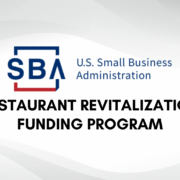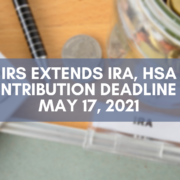U.S. Small Business Administration Awarding Funding Through the Restaurant Revitalization Funding Program
On March 11, 2021, the American Rescue Plan Act (ARPA) was announced as public law (P.L. 117-2) Section 5003, which appropriated $28.6 billion for the U.S. Small Business Administration (SBA) to award as funding to restaurants, bars, and other similar places of business that serve food or drink. Recipients are not required to repay the funding as long as funds are used for eligible uses no later than March 11, 2023.
Who is Eligible?
Eligible entities are businesses not permanently closed and include businesses where the public or patrons assemble for the primary purpose of being served food or drinks. Some examples include restaurants, food stands, food trucks, food carts, caterers, bars, saloons, lounges, taverns, and snack/nonalcoholic beverage bars. Bakeries, brewpubs, tasting rooms, taprooms, breweries, microbreweries, wineries, and distilleries must show documentation with their application that on-site sales to the public comprised at least 33% of gross receipts in 2019. Restaurants and bars also need to meet this 33% test, but do not appear to have a requirement to submit documentation with their application.
Per the SBA Program Guide (as of April 20, 2021), “Those entities without additional documentation requirements, such as restaurants and bars, are presumed to have on-site sales to the public comprising at least 33% of gross receipts in 2019. All applicants must attest in the application to the following: “The Applicant is eligible to receive funding under the rules in effect at the time this application is submitted.””
Where to Apply
The SBA is providing three ways of applying for the funding:
- Through an SBA recognized Point of Sale Restaurant Partners
- Directly through SBA Form 3172
- By calling SBA directly at (844) 279-8898
Currently the SBA has set registration for the application portal to begin on Friday, April 30, 2021, at 9:00 a.m. ET and application will open on Monday, May 3, 2021, at noon ET.
When to Apply
The SBA will start accepting applications from eligible participants after the pilot program has ended. The application process will be open to all who are eligible to receive funding, but for the first 21 days they will only process and fund those in the priority groups. The priority group is defined as those who are at least 51 percent owned and controlled by individuals who are women, veterans, and/or socially and economically disadvantaged individuals. After the initial 21-day period, the SBA will begin to process applications for all eligible participants.
The funding is on a first come, first serve basis, and the SBA has stressed the importance of applying as soon as possible as demand may exceed available funding.
Funding Amounts
The funding amounts for eligible participants are as follows:
- Calculation 1: For applicants in operation prior to or on January 1, 2019.
- 2019 gross receipts minus 2020 gross receipts minus PPP loan Amounts
- Calculation 2: For Applicants that began operations partially through 2019.
- (Average 2019 Monthly gross receipts x 12) Minus 2020 gross receipts minus PPP Loan Amounts
- Calculation 3: For Applicants that began operations on or between January 1, 2020 and March 10, 2021 and applicants not yet opened but will have eligible expenses incurred.
- Amount Spent on eligible expenses between February 15, 2020 and March 11, 2021 minus 2020 Gross receipts minus 2021 gross receipts (through March 11, 2021) minus PPP loan amounts
Gross receipts for the purpose of this program does not include:
- Amounts received from Paycheck Protection Program (PPP) Loans (First draw or Second draw)
- Amounts received from Economic Injury Disaster Loans or Grants
- State and Local grants (via CARES Act or otherwise)
- SBA Section 1112 payments
Allowable Use of Funds
Funds may be used for specific expenses including business payroll costs, payments on any business mortgage obligation, business rent payments, business debt services, business utility payments, business maintenance expenses, construction of outdoor seating, business supplies, business food and beverage expenses, covered supplier costs, and business operating expenses.
Documentation Required
For all applicants, a completed SBA Form 3172, verification of tax information IRS Form 4506-T and gross receipts documentation which includes but not limited to tax returns, bank statements, etc.
In Summary
The SBA is awarding funding for those eligible applicants that have been affected by the COVID-19 pandemic. Participants will be required to report, no later than December 31, 2021, via the application portal, how much of the grant has been spent on each category of eligible use of funds. Click on the links below access the SBA RRF Program Guide and RRF Sample Application:
It is indicated in the American Rescue Plan that amounts received from SBA in the form of a Restaurant Revitalization Funding grant shall not be included in the gross income of the entity that receives such funds. In addition, no deduction shall be denied, no tax attribute shall be reduced, and no basis increase shall be denied by reason of the exclusion from gross income provided above.
How We Can Help
Our team is available to assist you during the process of filing for the SBA Restaurant Revitalization Funding. We will update you with any changes to the program or application when released by the SBA. Please contact your trusted Scheffel Boyle team member with questions. We are always here to help!






